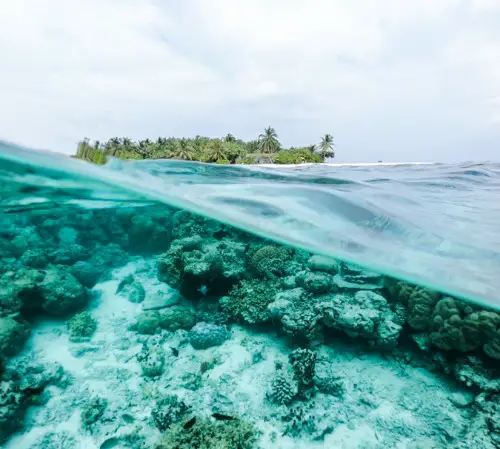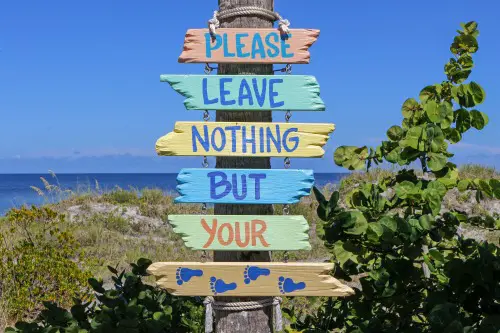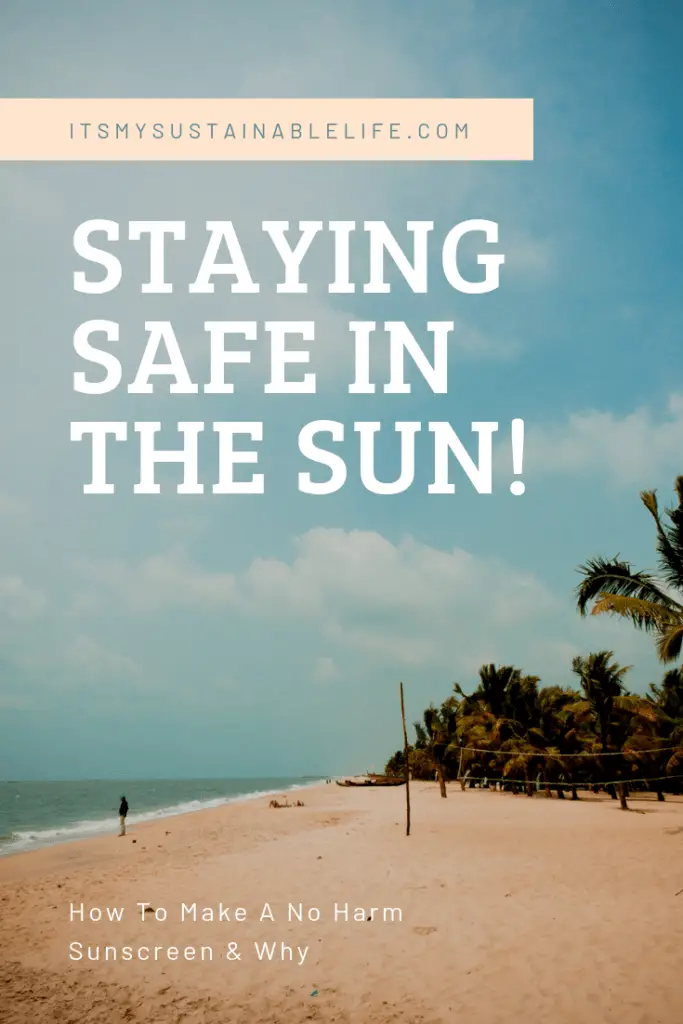Is staying safe in the sun and causing no harm to yourself or to our marine and waterway eco-systems possible? A resounding YES! Creating your own organic safe sunscreens, without all the harmful chemicals, will allow you to safely have fun in the sun while protecting the reef & marine life.
This post may contain affiliate links at no additional cost to you. By making your purchases through the links on this website, IMSL may make a small percentage at no direct cost to you. IMSL only promotes products we use & truly believe in. Please refer to my Privacy & Disclosures for further information. IMSL thanks you for your support!
Here in New England, with our long winters and delayed springs, there is no keeping me out of the sun once the weather warms a bit. I love the sun. It rejuvenates me. It feeds my soul & gives me energy. Between my long hours gardening & working on outside projects, I definitely get my daily dose of Vitamin D in the warmer months. Being extremely conscious about what I choose to lather on my body, using a safe, organic, & effective sunscreen/sunblock was paramount to me spending so much time in the sun.
There are two main forms of sunscreen/sunblocks. Chemical and mineral. While the chemical forms utilize, well, chemicals, to block the harmful UVA and UVB rays, the mineral utilizes, well, minerals, to form a barrier to the harmful rays 🙂 . Minerals like zinc oxide and titanium dioxide are commonly used as they are considered broad spectrum (blocking both UVA & UVB).
I feel it should also be noted that appropriate sun exposure can actually BENEFIT us! Music to my ears!! Although sunburn is never good for your health, utilizing traditional sunscreen/sunblocks, do just that. They block the suns rays including our ability to absorb the much-needed vitamin D our bodies & bones need.
Studies are now confirming that appropriate sun exposure can actually help prevent some skin cancers & improve survival rates. According to an Italian study published in 2008:
– NCBI
it “confirms the finding that sun exposure prior to diagnosis of melanoma is associated with improved survival”.
Conventional sunscreens are just not an option (for me anyway) any longer. Research is now confirming that the toxic ingredients in these products may harm not only ourselves but the environment as well. Specifically, our waterways and reef systems. More on that issue below. Even many organic options contain questionable ingredients, making them a non-option for me.
WHAT’S THE HARM?
Many people are asking, “What’s the harm? I’ve been using traditional sunscreens all my life!”. I too can be included in that statistic. I grew up using the well-known brand of sunscreen that became popular during the ’70s & ’80s. To this day, I still love the smell of this brand :).
So what is the harm? Chemicals. These conventional sunscreen/sunblocks are filled with toxic chemicals. According to this article, “The Trouble With Ingredients In Sunscreens”, there are two kinds of active ingredients in sunscreens. Mineral & chemical filters. The common sunscreens you find on your shelves today are filled with chemical filters. Many of these chemicals act as endocrine disruptors with the most “worrisome” being oxybenzone, according to EWG.
– EWG
“EWG has reviewed the existing data about human exposure and toxicity for the nine most commonly used sunscreen chemicals. The most worrisome is oxybenzone, which was added to nearly 65 percent of the non-mineral sunscreens in EWG’s 2018 sunscreen database. Oxybenzone can cause allergic skin reactions (Rodriguez 2006). In laboratory studies it is a weak estrogen and has potent anti-androgenic effects (Krause 2012, Ghazipura 2017)”.
This same article states that 96% of the American population has traces of oxybenzone in their systems. Young adolescent males with higher levels of this chemical show decreased levels of testosterone, there are known links between pregnancy & birth results, & it doesn’t just affect the young as there are reduced rates of testosterone in adult males as well.
This chemical not only is an allergen and acts as a hormone disruptor in humans, but also has direct, damaging effects to our coral reefs & thus indirectly to our marine life. According to an article, “EWG’s Sunscreen Guide”,
– EWG
In laboratory experiments, oxybenzone caused damage and deformation of coral by acting as an endocrine disruptor and damaging the DNA of coral larvae. Oxybenzone has also been shown to cause coral bleaching and even coral death. Legislators in Hawaii recently passed a bill, not yet signed into law by the governor, to ban the sale of oxybenzone-containing sunscreen due to its effects on marine life.
With over 5000 metric tons of chemical ridden sunscreen pollutants entering our waterways yearly, this level of pollution is alarming & definitely unsustainable.

So what EXACTLY is in most conventional sunscreens? Here is a list of some of the chemicals that I find most concerning. Please note that some of these chemicals can also be found in mineral sunscreen/sunblocks as well. Reading & understanding your labels will be your best approach when deciding which is appropriate for you.
- Vitamin A – Yes you heard me right, Vitamin A and it’s derivatives retinol & retinyl palmitate to be specific. Retinyl palmitate has been found to actually INCREASE the risks of accelerating skin cancers. (EWG: The Problem With Vitamin A).
- Octyl Methoxycinnamate (OMC) – An organic compound used to absorb UVB rays from the sun. It has been shown to increase toxicity levels in cells. (Toxicity and Phototoxicity of Chemical Sun Filters).
- Octocrylene – An organic compound used as a UV filter and shows increased skin allergies. (The Trouble With Sunscreen Ingredients – EWG).
- Avobenzone – Used as a UVA filter that is unstable in sunlight and must have stabilizers used in conjunction. Although it shows no hormone disruption it does carry with it increased skin allergies.
- Oxybenzone – A UV filter with high levels of toxicity issues as stated in depth above.
- Homosalate – A UV filter with considerable risk. A hormone disruptor affecting estrogen, androgen, and progesterone levels. This chemical has been detected in mothers milk.
- Octinoxate – Another UV filter that has shown hormonal-like activity as well as “alterations” in animals reproductive systems, thyroids, & behaviors.
These are just a few of the active chemicals that you will find in the most common sunscreen/sunblock options on the market today. In addition to these active chemicals, you will also find many in-active ingredients which make up 50-70% of the base. One of particular concern is methylisothiazolinone. According to EWG’s “The Trouble With Ingredients In Sunscreens”,
– EWG
Laboratory studies indicate that methylisothiazolinone is a skin sensitizer or allergen. Over the past several years, physicians have reported serious cases of skin allergies, most notably in children exposed to methylisothiazolinone, from baby wipes and other products meant to be left on the skin (Chang 2014). In a study published in 2014, researchers at Baylor University surveyed the ingredients in 152 children’s body care products labeled “hypoallergenic” and found methylisothiazolinone in 30 of them (Schlichte 2014). Three of the sunscreens in this year’s database are marketed for use on babies.
ENVIRONMENTAL CONCERNS
Not only are these chemicals a danger to ourselves & our health, but they are also being linked to the destruction of our coral reef systems and thus our marine life. As an avid diver in my earlier years, this is most alarming. Recent studies show that many of the compounds in sunscreens harm the ocean life & coral systems. “Swimmers pollution”, that oily sheen seen on the surface of bodies of water, threaten the coral systems & marine life throughout the world.
According to Marine Safe “Sunscreen Pollution”, swimmers pollution does not only enter our water systems by “washing” off our bodies. Oxybenzone is readily absorbed through the skin. This chemical can be detected within 30 minutes of application through urine samples. According to this same article by Marine Safe:
– Marine Safe
When you flush the toilet or wash off sunscreen in the shower, chemicals from the lotion enter the sewer. For towns near coral reefs and without sophisticated sewage treatment and management systems, this pollution is rather inevitable.
In 2015 Marine Safe studied this same chemical for its toxicological effects on coral larvae. They found that this chemical causes the following devasting results:
– Marine Safe
We found that oxybenzone induces coral bleaching by lowering the temperature at which corals will bleach when exposed to prolonged heat stress. We also showed that oxybenzone is genotoxic, meaning that it damages coral DNA as well as induces severe and lethal deformities. Most alarming, we determined that oxybenzone also acts as an endocrine disruptor, causing the coral larvae to inappropriately encase itself in its own stony skeleton — at a time in its development when it should not even have a skeleton.
The devastation of our most famous coral reef systems from using these chemicals, unfortunately, does not stop short at just the reef systems. “It’s toxic to algae, sea urchins, fish and mammals.” It can impact gender mutations in fish, and has been shown that dolphins (and humans) can pass this to their newborns through their breastmilk.

Armed with this information, it just reaffirms my old diving adage to visit but leave nothing behind except bubbles…and in this case footprints as well.
WHAT ARE WE TO DO?
Personally, I know what I’m NOT going to stop doing! Going to the beach and enjoying my time in the sun. There are many natural ways to protect yourself from over-exposure to the sun.

- Plan your outings. Avoid peak hours, between 10-2, when the sun is at it’s strongest.
- Use the shade to your advantage. Whether natures shade or umbrella’s, enjoy the outdoors without direct sun.
- Cover with clothing. Use hats and long-sleeved shirts when out for prolonged periods.
- Make your own organic sunscreen.
HOMEMADE ORGANIC SUNSCREEN
Making your own personal care products is a way to save yourself & the environment from overexposure to chemicals. It is not difficult or time-consuming. It is a personal choice that I make for myself & my family to help reduce our overall exposures.
Homemade sunscreens are not extensively lab tested as conventional lotions are. That is not to say, however, that they don’t work. They also don’t carry with them the harmful chemical load that traditional lotions contain.
INGREDIENTS & APPROXIMATE SPF’S
The following list of ingredients contains an “approximate” naturally occurring SPF. As these products are not “tested” by any regulatory organization, an exact total SPF cannot be guaranteed. I recommend creating a starting point, give it a trial, and adjust accordingly to your specific needs.
- Shea Butter – SPF 4-6
- Coconut Oil – SPF 4-6
- Almond Oil – SPF 5
- Red Raspberry Seed Oil – SPF 25-50
- Carrot Seed Oil – SPF 35-40
- Zinc Oxide – SPF 2-20 (amount dependent)
- Beeswax – 0
Homemade Sunscreen
If you have never made homemade lotions or personal care products, I highly recommend you check out my post for an in-depth tutorial HERE prior to making this recipe.
HOMEMADE SUNSCREEN INGREDIENTS
- 1/2 C Almond Oil (can substitute your favorite carrier oil such as Jojoba or Olive Oil)
- 1/4 C Coconut Oil
- 4 Tbl Shea Butter
- 3/4 Tsp Red Raspberry Seed Oil
- 3/4 Tsp Carrot Seed Oil
- 2 Tbl Zinc Oxide (use only non-nano, uncoated version as it will not be absorbed)
- 1/4 C Beeswax
- Optional: essential oils for scent or vanilla extract. Please note the following list of essential oil are TOXIC to marine life: tea tree, clove, frankincense, eucalyptus, lavender, lemon, and peppermint.
MAKE IT
- Combine the Almond Oil, Coconut Oil, Shea Butter, and Beeswax in a double boiler.
- Over medium heat, melt all the ingredients, stirring frequently.
- Remove from heat.
- Add Red Raspberry & Carrot Seed Oil as well as any scents you may want. Stir to combine thoroughly.
- Being careful not to inhale the powder, add the Zinc Oxide & mix well.
- Let cool thoroughly, mixing to combine any of the Zinc Oxide that may have settled to the bottom.
Whisk to your desired consistency.
NOTES
- Wear a mask if needed when incorporating the Zinc Oxide into the mixture. You do not want to inhale!
- Beeswax can be adjusted up or down according to how thick or thin you like your lotion.
- This is NOT a waterproof lotion. I highly recommend reapplying as needed after swimming or physical exertion!
- Adjust the amount of Zinc Oxide to meet your needs.
By taking precautionary steps, you can enjoy your time in the sun in a healthy and environmentally conscious way. Do you have a favorite sunscreen? Love for you to share! Stay safe in the sun & while you’re at it, be sure to follow IMSL on all social media channels to stay up-to-date with all the “happenings on the hill”.
Love, Light, & Laughter ~

*This recipe has not been tested by any authorized lab or agency. This is a homemade recipe. I am not nor claim to be a doctor of any kind. Please do your due diligence & inquire with your physician or qualified professional any concerns or questions you may have concerning this post.



13 comments
What a great post! I’ve been seeing so much about how toxic sunscreen is for us in the news lately, and how they are reporting it causing more cancer than the actual sun. So crazy, seeing as most of us have lathered it on like crazy for as long as we can remember. I love all of the research you did to put this together, and it’s such great information. I pinned it for later! 🙂
Thank you, Darcy! I think you are feeling the way most are…betrayed.
Lot’s of information. Something to think about!
So much information that is withheld from we the consumers. Sadly, I feel this article is just the tip of the iceberg!
I might need to try that homemade sunscreen on my fiance! He has a lot of Irish in him, so he burns easily!
I would love to try this recipe, and thank you for the in-depth article as to WHY! Where do you buy your ingredients?
I normally source through Amazon as I live in the middle of no-where and do not have access to good, organic ingredients. I love better shea butter (.com) products and use them frequently.
I always use EWG for my cosmetics! I love their App! It makes it so easy to check toxicity of cosmetics and sunscreen! I have a family of seven and we go through a lot of sunscreen! The problem is the good stuff is expensive! Is this fairly economical to make?
It’s a bit of an investment initially to gather all the ingredients, but the good news is it goes a long way 🙂
Thanks for this article Suzan! All my friends make fun of me because I’m a ‘shade chaser’ – I chase the shade all day as it moves throughout the day! I absorb sun like a solar panel so I have to be really careful. I just haven’t found a sunscreen I like because everything feels so heavy and they actually make me hotter (in a not good way!) I may have to try this homemade kind to see if it feels better. Thanks!
I hope this works for you. Let me know how you like it!
What an informative read! It is crazy that the big sunscreen companies that are seen in the store know about these dangers also, but still, continue to use the toxic chemicals. I have tried making my own sunscreen before and FAILED. It was a different recipe than this, I will have to try yours and see. To get store bought all natural organic sunscreen costs so much!
I find it unfathomable that these companies are allowed to continue to mislead consumers as well! Thank you for stopping by 🙂